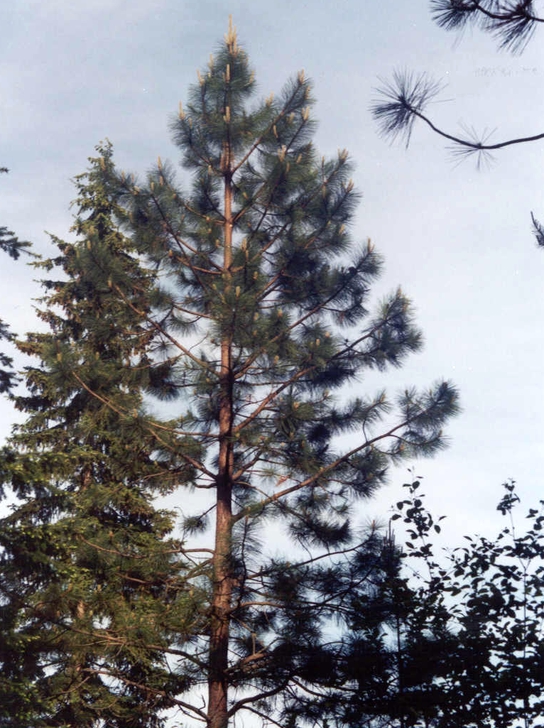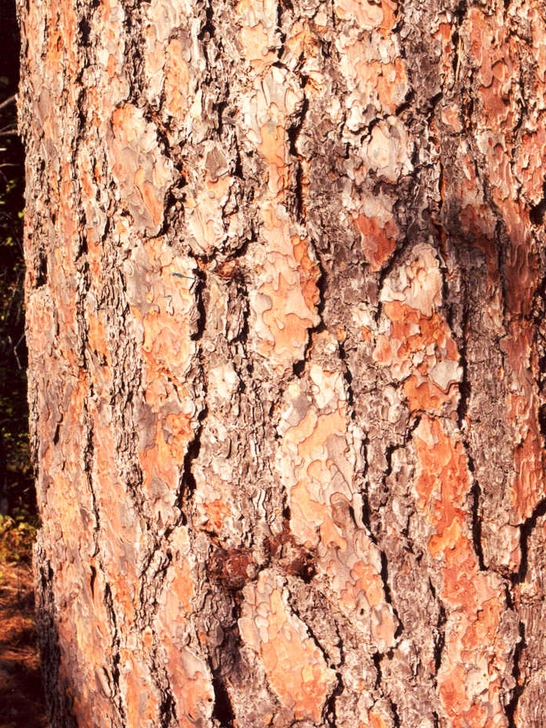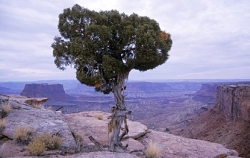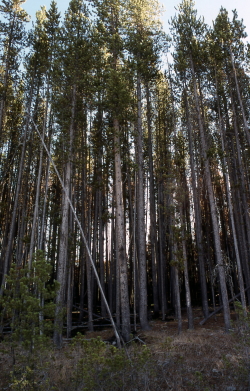
Ponderosa Pine
Western Yellow Pine
Pinus ponderosa
Courtesy USDA Forest Service

Ponderosa Pine Needles
Courtesy US NPS from a US BLM Photo

Ponderosa Pine Bark
Courtesy USDA Forest Service

Ponderosa Pine Distribution
Courtesy US National Parks Service, Bryce Canyon National ParkI’ve been accused of being a tree hugger over the years, a title I welcome! I’ve hugged many trees, as I’ve hugged many people, especially on Valentine’s Day! One tree that I’m particularly fond of hugging is the ponderosa pine- with its sweet butterscotch aroma meeting my nostrils!
A few weeks ago, I was skiing with friends through a lovely ponderosa forest in Bryce Canyon National Park. The trees had a special beauty with their fresh cover of snow and frost crystal. As my skis and I worked our way through the forest, many questions regarding these magnificent trees arose- how were they being managed by the park, other than controlled burns? It appeared to be a well-structured forest, a multi-aged stand from seedlings to much older members of “yellow bellies”, a name given to mature, older pines whose bark wore a yellowish-gold cast. When was the last fire where I skied?
This dry-land forest loves a good, cleansing burn every so often to keep it healthy and fecund, reducing the fuel load to prevent catastrophic fires that may kill the trees. Often occurring at higher elevation and towering over their lesser neighbors of limber pine, Douglas fir, subalpine fir, and juniper, they serve as highly effective lightning rods. More than 100 feet heights are common for these monarchs. Under ideal growth conditions, they may pierce the sky at 200 feet and over five feet in diameter! The oldest recorded ponderosa is 933 years although they average 300-400 years.
Ponderosa’s are among the highest valued lumber trees in the west. Most of the old growth ponderosas have been cut unless they’ve had special protection in parks and preserves. I’ve found small patches of trees well over 200 years in age, living long before the axes and saws appeared in the western US.
Native Americans ate the seeds either raw or made into a bread and the sweet, edible phloem in the inner bark. They used the pitch as adhesive and waterproofing agent for canoes, baskets and tents. Blue dye was produced from a root extract. The long needles were woven into baskets.
Many species of wildlife are found in these marvelous forests, some completely dependent on them, like the Abert’s squirrel. This squirrel species truffle feeding behavior has a symbiotic relationship with the ponderosa by spreading truffle spores through defecating and burying them, which form mycorrhiza with ponderosa tree roots allowing them to thrive.
There is less canopy cover in a ponderosa pine community compared to lodgepole pine and spruce/fir communities, resulting in more grasses, forbs, and shrubs. The high species richness of the understory makes it preferred by grazing animals such as elk, deer, and moose. A ponderosa forest bird I’m particularly fond of is the communal pigmy nuthatch. Their busy, constant chatter always brightens my day-including winter days in Bryce.
I recently read a delightful book on the ponderosa “Graced by Pines” by Alexandra Murphy, a wonderful read to pass these long winter nights.
Jack Green for Bridgerland Audubon Society and I’m Wild About Utah!
Credits:
Ponderosa Pine Pictures: Courtesy US NPS,
Bark Picture Courtesy US NPS, Rocky Mountain National Park, https://www.nps.gov/romo/ponderosa_pine_bark.htm
Audio: Courtesy & © Friend Weller, https://npr.org/
Text: Jack Greene, Bridgerland Audubon, https://bridgerlandaudubon.org/
Additional Reading: Lyle W Bingham, Webmaster, and Jack Greene, Author, Bridgerland Audubon, https://bridgerlandaudubon.org/
Additional Reading:
Jack Greene’s Postings on Wild About Utah, https://wildaboututah.org/author/jack/
Ponderosa Pine, Bryce Canyon National Park-Utah, US National Park Service, Department of the Interior, https://www.nps.gov/brca/learn/nature/ponderosapine.htm
“The Cheyenne Indians of Montana applied ponderosa pine pitch inside whistles and flutes to improve the instruments’ tone. The Nez Pierce used the pitch as a torch fuel; the Nez Pierce and Crow also used pitch as glue.”
Ponderosa Pine, Range Plants of Utah, USU Cooperative Extension, Utah State University, 2017, https://extension.usu.edu/rangeplants/shrubs-and-trees/PonderosaPine
“Ponderosa pine is unpalatable to domestic livestock but it may browse enough to slow or stop seedling recruitment. Pregnant cows that consume large amounts of ponderosa pine needles show an increased incidence of abortion and other reproductive anomalies.”
Ponderosa Pine (Pinus ponderosa), Poisonous Plant Research: Logan, UT, Agricultural Research Service(ARS), US Department of Agriculture, https://www.ars.usda.gov/pacific-west-area/logan-ut/poisonous-plant-research/docs/ponderosa-pine-pinus-ponderosa/
World’s Oldest Ponderosa Pine Found in Utah Fire Study, Utah Forest Landowner Education Newsletter, USU Extension, Utah State University, Volume 12, No 1, Winter 2008, https://www.fs.usda.gov/Internet/FSE_DOCUMENTS/fsbdev7_016042.pdf



